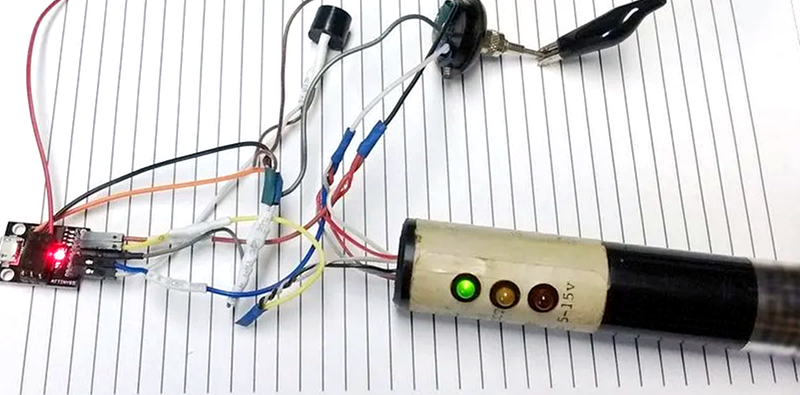We live in a day when it is very inexpensive to buy an oscilloscope, especially one with modest performance that hooks to a laptop. However, there was a time when even a surplus scope was out of reach for many people who liked to build things. A common alternative was the logic probe. At the low end, this could be an inverter and an LED, although it was more common to have a little extra circuitry to actually do a comparison to a reference voltage and present some indication of fast pulses — you might not be able to tell the frequency of a clock, but you could tell it wasn’t stuck. Of course, today with a microcontroller you can make a very sophisticated probe with less circuitry than a classic probe. We’ve seen a few takes on this and the latest is the DigiLogicProbe from [TheRadMan].
The probe is just a ATtiny85 board with a handful of components. A resistor and diode help protect the probe and the circuit under test. There are also a few LEDs and a buzzer. The rest of the project is software.
The probe, of course, can do the classic functions or even act as a continuity tester. [TheRadMan] has more plans, though. He’s looked at the venerable SuperProbe project which does the same kind of trick and can do things like read serial data, measure capacitance, inject pulses and drive servos, among other things. There’s also the Little Helper and doubtless others out there.
If you start following links to all these helpers you will find the hard part might not be the design, but finding a suitable case. Many times people will repurpose an old logic probe or similar device. A piece of PVC pipe is another common alternative. Then again, you can always fire up your 3D printer.
















I can’t imagine designing even a basic Arduino project without an oscilloscope. The first time you have trouble with a SPI port or a DC-DC converter, you’re pretty much poking around in the dark.
But now, even a starving student can have his own scope. You can probably find a decent unit on eBay for $200, or a brand new Rigol model for $400.
When I’m troubleshooting, or developing something new, I feel blind without a ‘scope. Back in the ’70s, as a teenager, I used an old Eico ‘scope and a military surplus ‘scope I got at hamfests. I built and added triggerd sweep sections for them a *huge improvement*, but I was stuck with the AC coupling. In the early ’80s, I got a Tektronix 535, followed by some 545As. I got them, usually not working, at hamfests and repaired them. I usually paid between $50 and $100. Later I started reselling them myself at hamfests after being repaired.
Carl I understand. I have several O-scope portables and the China standalone micro mini LCD Oscilloscope. I have several probes but this idea has been rolling aroound a bit, and the digispark micros are *small*. I get your point, There are sub-100 scopes on AliBahBah. I just wanted to contribute and give back. I have built a few hackaday suggested tools. John Rad
Ya’all contenders for EEVBlog’s “how many ‘scopes are too many” Thread. But i can understand the addiction, My first and only scope I inherited from my father, https://www.radiomuseum.org/r/panasonic_oscilloscope_vp_5100a.html , and now i’ve just ordered the rigol 1054z , it’s going to be strange moving to a DSO for the first time, althought I have used a OSL Sniffer for some time you just cant beat the feedback from a scope.
just get a logic analyzer from ebay for a few dollars; perfectly usable
https://www.ebay.co.uk/itm/LHT00SU1-Virtual-Oscilloscope-USB-Device-I2C-SPI-24MHz-Logic-Analyzer-for-M100/292586000545?hash=item441f7c10a1:m:mxQh26tKllsexY_1vrqTvtg:rk:1:pf:0
Can you carry the O’scope in your pocket to the Escape Room site,
troubleshoot the TTL sensors while trying to octopus-hold a Flashlight at the same time?
Al Williams : many thanks for the PVC pipe suggestion, I am going to hunt for PVC end-caps tonight.
I need to make more of these probes because the Escape Room Owners now want the tool.
and Dan Maloney ; I have read many article on Hackaday since 2014
and built some of the useful portable gear for my mobile toolkit. Thank you for your publishing.
Debugging with just a logic probe forced you to think creatively. Its amazing what you can come up with. Can’t say the same with a scope.
I’m a self-taught electronics hobbyist and my domain of experimentation for the past several years has been analog RF electronics (mostly building shortwave receivers, HF oscillators, HF amplifiers and filters, and AF amplifiers). At the beginning of my experimentation I thought I needed an oscilloscope, but then I discovered circuit simulation and dove into that instead. For the kind of circuits I am building, and the kind of questions I need to answer, I found that circuit simulation allowed me to design my own circuits with a high degree of success. The questions I needed to answer were things like, “does this circuit, with a 2N3904 transistor and resonator Q of 100, have enough gain to oscillate at 7 MHz”, or “how smoothly does the oscillation amplitude change with response to changes in base bias”, or “how much gain can I expect from a particular configuration of tuned and/or untuned amplifiers”? After using the circuit simulator (LTspice, in my case) to design a feasible circuit, I then build it and iron out the final issues in hardware (spurious oscillations, parasitic couplings, etc.).
So in my case I found that using a circuit simulator obviated my need for an oscilloscope. Again, this is in the case of analog RF electronics, where the basic behavior of amplifiers and oscillators is already known. I can see how with digital circuits, where you need to visualize some kind of arbitrary data stream at a particular point in time, an oscilloscope might be indispensable.
See also:
http://mondo-technology.com/super.html
Aw man, brainfart. Linked right in the article. Mea culpa.